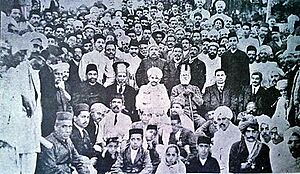Harchandrai Vishandas facts for kids
Quick facts for kids
Harchandrai Vishandas
|
|
|---|---|
| Born | 1 May 1862 Manjhu (Sindh),
Bombay Presidency, British India (Present day: Manjhu, Jamshoro District, Sindh, Pakistan) |
| Died | 16 February 1928 (aged 65) |
| Nationality | British Indian |
| Occupation |
|
| Known for | Father of Modern Karachi |
Harchandrai Vishandas C.I.E. (born May 1, 1862 – died February 16, 1928) was an important person in British India. He was a lawyer, a politician, and even the mayor of Karachi. Today, Karachi is a big city in Pakistan.
Many people call him "the father of modern Karachi." He did a lot for the people of Sindh, especially in education and politics. He helped shape Karachi into the city it is today.
Harchandrai was one of the first young men from Sindh to graduate from Elphinstone College in Bombay. This was before 1887. After finishing his law studies in 1885, he worked briefly in a court in Shikarpur. But he soon started his own law practice in Karachi. He was the elected Secretary of the Karachi Bar Association for 38 years, starting in 1890.
In 1888, Harchandrai was elected to the Karachi Municipality. He then served as the mayor of Karachi for ten years, from 1911 to 1921. As mayor, he worked on making the city more beautiful. He helped build new roads, parks, and places for people to live and relax. He was also part of important government councils until he passed away in 1928.
Contents
Harchandrai's Early Life
Seth Harchandrai Vishandas was born in 1862. His birthplace was a village called Manjhand in Sindh. His family, the Bharvanis, were known for helping their community.
He first went to a school in Manjhand. His father, Seth Vishandas Nihalchand, had started this school. After that, Harchandrai went to Kotri for his middle education. He studied at a missionary school there. Later, he joined NJV High School in Karachi. He finished high school in 1878.
After high school, Harchandrai moved to Bombay for higher education. He studied law at Elphinstone College. He later supported this college, which was his Alma mater. He earned his law degree in 1882.
His Professional Work
Working as a Lawyer
Harchandrai was a very skilled lawyer. He was a special lawyer called a Queen's Counsel under Queen Victoria. Later, he became a King’s Counsel under King Edward VII and King George V.
He first worked in the Shikarpur court. But his father convinced him to start his own law firm in Karachi in 1886. He was chosen to be the honorary secretary of the Karachi Bar Association.
Becoming Mayor of Karachi
Harchandrai was elected mayor of the Karachi Municipal Committee in 1911. He served until 1921. During his time as mayor, many things improved in the city. Gas lamps were put on the streets, and footpaths were added.
Electricity came to Karachi in 1913 because of Mayor Harchandrai. This is why Karachi is still called the "city of lights." It's interesting because electricity didn't become common in the US until 1920. He also helped change the path of the Lyari River. This created new land for building and development in the city.
Helping Society and Politics
Seth Harchandrai was also a freedom fighter for India.

He was the first Sindhi person to join the Indian National Congress. This group worked hard for India's freedom. Harchandrai was very important in the Congress party. In 1913, the 28th meeting of Congress was held in Karachi. This happened mostly because of Harchandrai, his father Seth Vishandas, and Ghulam Mohamed Bhurgari. He also led many Congress meetings in Sindh.
Harchandrai believed that Hindus and Muslims should live together in peace. He was also interested in Sufism. He became a member of The Theosophical Society.
His Final Days
Harchandrai Vishandas passed away on February 16, 1928, in Delhi. At that time, a British group called the Simon Commission came to India. Their job was to check on some government changes. The Congress party wanted to boycott this group.
Harchandrai's vote was very important for this boycott. Even though his doctor and friends told him not to travel, he left Karachi. He was determined to vote against the Simon Commission. Sadly, he died suddenly on his way from the railway station to the Assembly Hall.
On February 16, 1934, six years after his death, a statue of Harchandrai was put up. It stood in front of the Karachi Municipal Corporation Building. However, it was removed shortly after India was divided in 1947.

